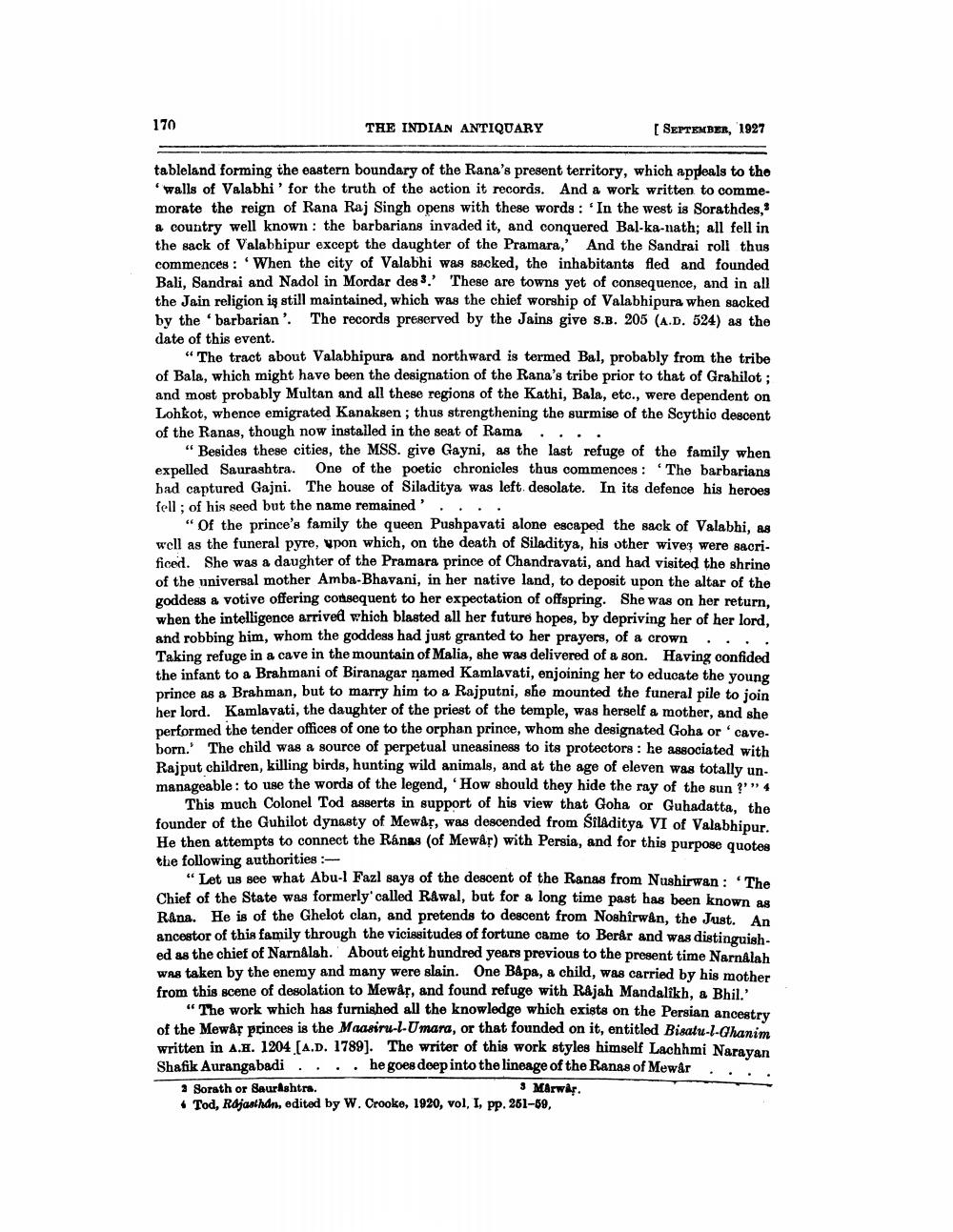________________
170
THE INDIAN ANTIQUARY
[ SEPTEMBER, 1927
tableland forming the eastern boundary of the Rana's present territory, which appeals to the
walls of Valabhi' for the truth of the action it records. And a work written to commemorato the reign of Rana Raj Singh opens with these words : In the west is Sorathdes, a country well known : the barbarians invaded it, and conquered Bal-ka-nath; all fell in the sack of Valabhipur except the daughter of the Pramara,' And the Sandrai roll thus commences : When the city of Valabhi was sacked, the inhabitants fled and founded Bali, Sandrai and Nadol in Mordar des 3.' These are towns yet of consequence, and in all the Jain religion is still maintained, which was the chief worship of Valabhipura when sacked by the 'barbarian'. The records preserved by the Jains give 8.B. 205 (A.D. 524) as the date of this event.
“The tract about Valabhipura and northward is termed Bal, probably from the tribe of Bala, which might have been the designation of the Rana's tribe prior to that of Grahilot ; and most probably Multan and all these regions of the Kathi, Bala, etc., were dependent on Lohkot, whence emigrated Kanaksen ; thus strengthening the surmise of the Scythio descent of the Ranas, though now installed in the seat of Rama ... .
"Besides these cities, the MSS. give Gayni, as the last refuge of the family when expelled Saurashtra. One of the poetic chronicles thus commences : The barbarians had captured Gajni. The house of Siladitya was left desolate. In its defence his heroes fell; of his seed but the name remained'....
"Of the prince's family the queen Pushpavati alone escaped the sack of Valabhi, as well as the funeral pyre, upon which, on the death of Siladitya, his other wives were sacri. ficed. She was a daughter of the Pramara prince of Chandravati, and had visited the shrine of the universal mother Amba-Bhavani, in her native land, to deposit upon the altar of the goddess a votive offering consequent to her expectation of offspring. She was on her return, when the intelligence arrived which blasted all her future hopes, by depriving her of her lord, and robbing him, whom the goddess had just granted to her prayers, of a crown.... Taking refuge in a cave in the mountain of Malia, she was delivered of a son. Having confided the infant to a Brahmani of Biranagar named Kamlavati, enjoining her to educate the young prince as a Brahman, but to marry him to a Rajputni, she mounted the funeral pile to join her lord. Kamlavati, the daughter of the priest of the temple, was herself a mother, and she performed the tender offices of one to the orphan prince, whom she designated Goha orcave. born. The child was a source of perpetual uneasiness to its protectors : he associated with Rajput children, killing birds, hunting wild animals, and at the age of eleven was totally un. manageable: to use the words of the legend, 'How should they hide the ray of the sun ?'” 4
This much Colonel Tod asserts in support of his view that Goha or Guhadatta, the founder of the Guhilot dynasty of Mewår, was descended from Siladitya VI of Valabhipur. He then attempts to connect the Ránas (of Mewår) with Persia, and for this purpose quotes the following authorities -
"Let us see what Abu-l Fazl says of the descent of the Ranas from Nushirwan : The Chief of the State was formerly' called Rawal, but for a long time past has been known as Rana. He is of the Ghelot clan, and pretends to descent from Noshirw&n, the Just. An ancestor of this family through the vicissitudes of fortune came to Berar and was distinguish ed as the chief of Narnålah. About eight hundred years previous to the present time NarnAlah was taken by the enemy and many were slain. One B&pa, a child, was carried by his mother from this scene of desolation to Mewar, and found refuge with Rajah Mandalikh, a Bhil.'
"The work which has furnished all the knowledge which exists on the Persian ancestry of the Mewar princes is the Maasiru-l-Umara, or that founded on it, entitled Bisatu-l-Ghanim written in A.H. 1204 (A.D. 1789). The writer of this work styles himself Lachhmi Naravan Shafik Aurangabadi.... he goes deep into the lineage of the Ranas of Mewar... 1 Sorath or Saurishtrs.
3 Marwar. Tod, Rajasthan, edited by W. Crooke, 1920, vol. I, pp. 261-69,




